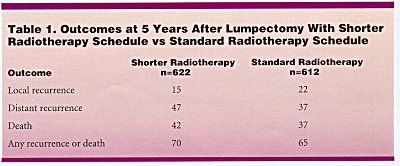Study Validates Shorter Radiation Schedule
NEW ORLEANS-A 3-week radiation schedule after lumpectomy is as effective as the standard 5-week schedule in terms of local control, overall survival, and cosmetic outcomes, Canadian researchers reported in a plenary presentation at the 36th Annual Meeting of the American Society of Clinical Oncology (ASCO).
NEW ORLEANSA 3-week radiation schedule after lumpectomy is as effective as the standard 5-week schedule in terms of local control, overall survival, and cosmetic outcomes, Canadian researchers reported in a plenary presentation at the 36th Annual Meeting of the American Society of Clinical Oncology (ASCO).
Timothy Whelan, MD, of the Hamilton Regional Cancer Centre, Hamilton, Ontario, Canada, said that the shorter schedule lessens the burden of therapy for the patient, and shortens the length of the treatment period by almost half for women with node-negative breast cancer.
The Canadian trial compared a shortened radiotherapy schedule of 42.5 Gy in 16 fractions in 22 days (arm A, n = 622) to a conventional schedule of 50 Gy in 25 fractions in 35 days (arm B, n = 612). All treatments were delivered daily Monday to Friday. Patients received no regional nodal irradiation and no boost irradiation.
The trial included women with node-negative breast cancer with clear resection margins following lumpectomy.
Cosmetic outcome was assessed at baseline, 3, and 5 years by a trained nurse using a modified version of the European Organization for Research and Treatment of Cancer (EORTC) Cosmetic Rating System.
No Significant Differences
At median follow-up of 5 years, 15 local breast recurrences were reported in arm A and 22 in arm B. The corresponding 5-year actuarial local breast recurrence rates are 2.5% for arm A and 3.3% for arm B.
No significant differences were seen in either distant recurrences or deaths between the two arms (see Table 1).

Cosmetic Outcome Equivalent
Dr. Whelan also reported that there were no significant differences in disease-free survival or overall survival, and that cosmetic outcomean indicator of late morbidity following radiation therapywas equivalent on both treatment arms (see Table 2).

The radiation schedule of 42.5 Gy in 16 fractions is as good as 50 Gy in 25 fractions in preventing local recurrence and producing a good cosmetic result, Dr. Whelan commented. The shorter schedule would also allow almost 50% more patients to be treated with available resources.
Despite the good results with shorter radiation therapy in this trial, medical oncologists in the United States will await the long-term results from this study and from the UK START trial of increased radiation fraction size before changing their practice, commented discussant Jay Harris, MD, of Brigham and Womens Hospital, Boston, Massachusetts. This is due to concern about long-term side effects, he added.
Late side effects such as brachial plexopathy and myocardial infarction are typically seen more than 5 years after treatment, Dr. Harris noted.
Another concern is the deterioration in cosmetic result that may occur beyond 5 years after irradiation. With lower radiation doses, this deterioration stabilizes at 3 to 5 years after treatment, but this may not be true with larger doses, he said.